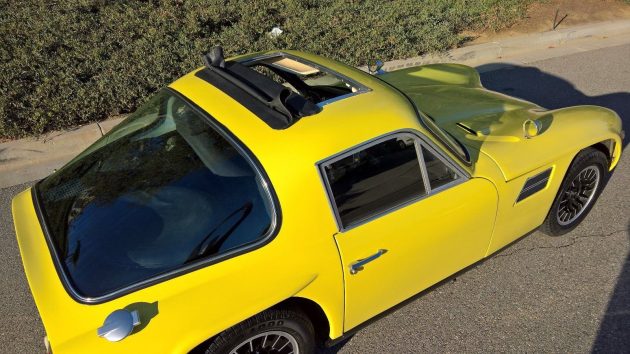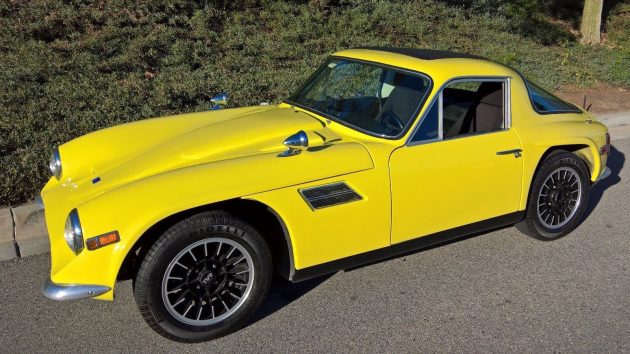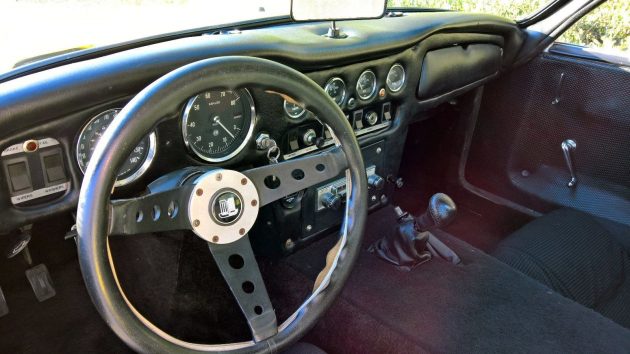Well now this is an interesting find, special thanks to Peter R for the tip! The TVR Vixen is a wonderful but rare sports car. That being said, they had one major issue, the Triumph inline 6 engine and the 106 horsepower it produces. Horsepower isn’t everything, being lightweight can make up for being underpowered, but sadly this engine isn’t terribly light. The owner of this one came up with an interesting way of solving the issue though, the swapped it out for an Alfa Romeo 2 liter with a 5 speed. It’s more powerful and lighter! You can find this Vixen here on eBay in Palos Verdes Peninsula, California with a current bid of $4,550.
Here is that Alfa engine! These twin cam Italian engines can really scream. The seller claims the car is about 200 pounds lighter now and has about 30 more horsepower! You can actually squeeze a lot of power out one of these 2 liters, so I don’t doubt the claim one bit. They don’t say what car the engine came out of, but I would guess it’s from a later Spider. I also imagine it makes this one lively little Vixen!
Having the Alfa 5 speed is a great bonus, but I’m a little concerned about the positioning of the shifter. It looks rather far forward to me. And what is going on with the hand brake? It might actually work great as is, but just need some finishing work to look right. The rest of the interior needs some work, so I would want to clean everything up and make a new plate for the top of the transmission tunnel while I’m at it. With a little work, I think this could be a decent interior for a nice weather driver.

I really love the oddball styling of these cars and the Alfa engine likely makes it a very fun car to drive! These engines have a great exhaust note and produce lots of torque. I’m curious to see what all went into making the engine fit. Given how few of these were built, it’s a bit sad to see it modified. Personally, I like the idea of having a twin cam in it, but I think I might have gone with a Ford Kent engine as that’s what TVR fit in the earlier Vixens. So what do you think of this swap? Do you think it’s really more reliable than the Triumph engine like the seller states?





Hard to say what model Alfa the engine is from. The oil pan and exhaust header are from an Alfetta, but those items are easily swapped.
12K Reserve not met
Well that is unexpected, and not a terrible conversion. The engine looks like a Spica era engine, but really everything can be switched on these alfa motors.
I am surprised they didn’t get the shifter location better. On the alfa they just bent the lever, which is why that it appears to come out of the dash on an alfa spider at an unusual angle.
It is a bit of a weird setup but I like it.
Better engine, more reliable and modern, less weight, more power, prettier to look at……should have been how they were built new. Great chassis with a great engine
Kent’s heavier, less powerful and Alfa’s 5-speed is nicer than Ford’s.
Fiat 131/132s went with the cranky gearlever too.
Looks like great fun. Rule one, make it lighter. Improves brakes and handling too.
Nice car! Did they swap the Alfa gauges in too?
seems nicely done, yet somehow I would have preferred to see the original engine left place.
In the seller’s comparisons I note that he rates the Alfa at 136 bhp versus the federal spec Triumph at 106 bhp. It does occur to me that the UK-spec Triumph 6 with fuel injection was more like 150 bhp and a great deal more torque than the Alfa. So the Triumph engine has plenty of potential power if you are unhappy with the US restricted version. …and it doesn’t take much work to upgrade the Triumph even on carburetors to better than 136, probably a lot less work than swapping in a completely different motor.
Still, the Alfa motor would be a lot lighter and would no doubt have a sportier feel…..
A modified 2 Lttr Alfa will produce 250 hp………
A really wildly modified alfa motor will produce 700 bhp, but will be about undriveable. In reality a hot normally aspirated alfa street motor tops out at around 195 and the average good street motor that is very tractable is about 155 to 160.
Considering that the shifter on the Griffith 200/400 was back around one’s elbow, that Alfa placement looks like a vast improvement.
@Dave Wright. Yes, I’m sure you’re right – the Alfa 2-litre has a lot more underlying potential that the Triumph motor. Though really, the point I was trying to make is that if your goal was to improve on the 106 bhp by replacing it with the 136 bhp of Alfa motor, you could also have achieved that sort of power very easily with the Triumph motor, with more torque almost certainly, with a few relatively modest changes. I would see that as a better path to upgraded performance than having to swap out the motor completely.
You could keep the original engine the car came with, make subtle changes that would mostly be indiscernible externally, and still have the extra performance you felt was needed?
Having said that, if the owner/seller of this TVR just felt like the Alfa motor was what he wanted, good for him.
I am admittedly not a huge British car guy, I have owned a few and of the over 20 vehicles I have here on the ranch today the only one is my late model Land Rover. I do have some Italian and lots of German products. If your goal is performance, I never understood buying a British car (exception to Lotus, Mini Cooper and Sunbeam tigers). Common British sports cars have some nice characteristics, many times they handle well and the styling can be fun but they have never been known for there advanced drivetrains. Most any good German economy car will blow the doors off an average MG or Triumph and still get you where you want to go and home again. Even some of the more touted British exotics like the V12 Aston Martin are little more than two Ford V6’s molded together. This car has a wonderful chassis that deserved better than a tractor engine. I am a purest in most cases but this adaption just makes sense. It mates a gem of a chassis with a gem of an engine that it should have had new. Another great alternative engine would have been a factory warmed up 2002 TII, that would have been a great car. I imagine the oppressive British unions had something to do with the engine choice. They have been strangling the quality and creativity out of the British car industry since the early 50’s.
Dave Wright,
Perhaps you’ve had enough eggnog for one night? LOL
I say that, only partly in jest, as you wrote this:
“If your goal is performance, I never understood buying a British car (exception to Lotus, Mini Cooper and Sunbeam tigers).
Read more at http://barnfinds.com/alfa-powered-1972-tvr-vixen-2500/#fjI5FvxfDrAg1lXf.99”
Uhm…please allow me to reacquaint you with the 1961 Jaguar XKE. Period testers got 150mph, OFF of the SHOWROOM FLOOR, with zero mods, from it’s inline six.
>>>>>>>>>>>>>>>>>>>>>>>>>>>>>>
And Josh–love what you do, and I’m willing to take your word that the Alfa four “produce[s] lots of torque” but there’s simply no way a (most-likely highly-“over-sqaure”) high-revving, 2.0L, Italian 4 cylinder is going to have the potential to make MORE torque than the Triumph inline six. The inline six, as configured by the vast majority of mfrs., has a longer stroke, relatively speaking, than do virtually all V-8’s, and a most four-bangers–particularly the “revv-happy” Alfa 4 cylinders.
IOW–if torque is what you’re after, the inline six is INHERENTLY better-suited to make more of it (in part due to it’s being more “UNDER-square,” i.e., having a longer “stroke-to-bore” ratio, relative to other engine configurations), than are traditionally more revv-happy OVER-square engines.
This is because a shorter stroke = easier revs, and therefore, higher H.P.,. whereas a longer stroke (as found in an inline six) = MORE torque, at the expensive of some H.P. at the upper end, as the longer stroke engine is not happy at the higher rev-ranges, where higher H.P. figures are achieved.
Make sense? I hope so.
I would have left the Big Six in place, and done “breathing mods” (headers, carburation-mods, etc…) if I wanted more H.P.
And let’s not forget that the TR6 engine/tranny combo was available, in Triumphs, with the (optional) “Laycock DeNormanville,” electric, two-speed overdrive, which allowed “split shifting” (yes, like a dump truck with a two-speed rear end, except this was an overdrive unit) in 3rd and 4th, for (effectively) SIX speeds.
I am not aware of TVR ever offering that Triumph option in the TVR, but IF the TVR’s more limited real estate allowed for that unit to be transplanted, along with the Triumph’s inline six, that would up the coolness factor even more….
I LOVE this era of TVR, btw–in part BECAUSE of the Triumph, inline six!
Peter
Cheers,
Peter
Old Jags are wonderful with there Italian (Colombo) designed engines. My Maserati Mistral….also a Colombo engine…….out performs them in any direction you wanted to go. British cars always look fast while racing each other, not so much on the street. All these comparisons between 6 cylinder large displacement British engines to 4 cylinder 2 Liter engines are common when you talk to British enthusiasts. Put them against most any 911, 3.0 CS, or anything else that really runs in there class……they are out classed. The engine in my Land Rover is quite good…..oh, it’s American too……even in more modern cars, what will run with my R500 mini van. Nothing British. To get a fast British car you have to look to some of the higher end Jaguar products but then you need to compare them AMG products…….no comparison there either. I have owned and raced many British cars, my Lotus 11 and 23 race cars were stunning but the engines were not the best. Most wound up with little Ford engines built in Cologne. My brother has several Lotuses today, the best one has an Isuzu engine from the factory or maby one of his Europas with a French engine? The Brits build great tractor engines, Massy Ferguson Perkins are wonderful. But as a sports car engine they are outclassed.
This is what a sports car engine should look like ind it is in my Italian sedan.
Ok first off the 02 motor would be difficult as it is canted over to the right side. The Alfa, Ford and triumph motors are all vertical.
I am a big Alfa fan, but I know the Triumph motor and it is actually a very fine motor and 150 BHP is just bringing these motors to European standards and 200 is relatively easy these days. The BMW 2002 Tii in stock trim only produces 140 BHP, so less than the Triumph motor.
Also the TR6, which is where this motor came from for the TVR was faster than the Tii in period never mind the standard ’02. By nearly a second zero to 60 and in the 1/4 mile. That is just by looking at old C&D road test. A Germany economy car from this period would have been what a VW bug.
I am a big fan of Italian motors and I could go into a litany of issues with the NORD motor, but overall it is a sweet motor. Personally though i would not have done this conversion and just tuned out the Triumph motor. I could make close to the same HP and more torque, and been the proper motor for the car.
The TR 6 is in the 911 range……….there is no comparison there
I’m looking very hard at this one. TVR’s and Alfa’s are on my list, here’s a two for one. What do you think the final winning bid will be ?
I’d have no idea how to maintain this thing, but it is a beauty.
It’s easy to plan the build, with our imaginary garage full of parts, but the builder probably simply used what he had on hand.
Rare or not these aren’t valuable, so any investment in a replacement engine is going to be either pragmatic or a thing of passion.
Going lighter while raising HP is a no brainer especially if the engine is already sitting around.
@Dave Wright. Well, the question of who had the best sports cars is a pretty subjective one, so I doubt we’ll ever get a consensus, but it’s good to discuss here !
As mentioned in other comments, there were certainly plenty of great high performance and highly desirable British sports cars at the exotic end of the scale like Jaguar and Aston Martins, and the Austin Healeys, MGs and Triumphs pretty much defined the affordable simple sports-car genre for years. True enough to say that by the later 1960s the old long-stroke cast-iron push-rod Triumph motors were technologically outclassed by the likes of Alfa and Fiat twin-cams.
Still, the Triumph six has a lot of charm. Great torque characteristics for a road-driven car, great exhaust note, pretty robust and reliable if properly looked-after, very easy and inexpensive to service or upgrade for performance.
BTW, the Triumph six was never a “tractor engine”. That derogatory term is usually aimed at the 4-cylinder TR engines, though even that connection is pretty tenuous. The 4-cylinder engine was designed for road car use in the Standard Vanguard. It was loosely based on another earlier design which WAS designed for tractor use. The 4-cylinder Vanguard car engine was then developed for use in the TR sports cars and also later used in the Ferguson tractors ( and in Morgan +4 cars !). The six cylinder engine was then very loosely based on the layout of the 4 cylinder engine……
Also, you refer to Jaguar engines which were Italian (Colombo designed) ? Which ones are you referring to? The XK series 6-cylinder engines and the v-12 engines were developed in-house by Walter Hassan, Walter Haynes (and in the case of the V-12 Harry Mundy). I can’t think of any Jaguar engines (prior to the Ford take-over) that were sourced from anywhere else – not counting the badge-engineered Daimler V-8s ?